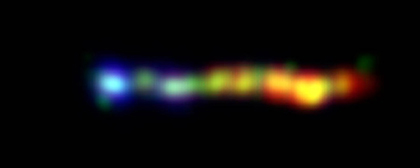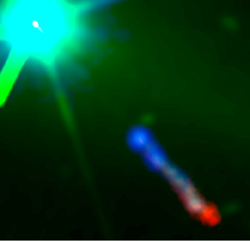For Release: June 20, 2006
Yale Release
New Haven, Conn. -- An international team of astronomers led by researchers at Yale has obtained key infrared observations that reveal the nature of quasar particle jets that originate just outside super-massive black holes at the center of galaxies and radiate across the spectrum from radio to X-ray wavelengths; a complementary study of jet X-ray emission led by astronomers at the University of Southampton, reaches the same conclusion.

Chandra, Hubble, and Spitzer composite of 3C273
Credit: NASA/JPL-Caltech/Yale Univ.
Press Image and Caption
Both studies involve the jet of the quasar 3C273, famous since its identification in 1963 as the first quasar. It now appears that the most energetic radiation from this jet arises through direct radiation from extremely energetic particles, and not in the way expected by most astronomers based on the previously available data. The two reports, available now online in the Astrophysical Journal, will appear in print in the September 10 issue.
"Quasar jets, although extremely luminous, are so distant as to be relatively faint and difficult to observe. Thanks to the sensitivity of NASA's Great Observatories, we have been able to map the 3C273 jet in infrared, visible light and X-rays," said C. Megan Urry, Israel Munson Professor of Physics and Astronomy at Yale, and an author on one study. "These combined data strongly suggest that ultra-energetic particles in the 3C273 jet are producing their light via synchrotron radiation."

Composite showing the relation between the quasar 3C273 (top left; the quasar is a very small and bright source, the fuzz apparently surrounding it is an artifact that appears when taking a picture of a very bright source with a camera and telescope for very faint things) and the jet. The color coding is the same as in the image above.
Credit: NASA/NRAO, S.Jester, D.E.Harris, H.L.Marshall, K.Meisenheimer, H.-J.Röser, & R.Perley
Jpeg | Tiff
There have been two competing theories of how emissions arise from the particles -- the "Inverse-Compton" theory proposing that the emissions occur when jet particles scatter cosmic microwave background photons, and the "Synchrotron Radiation" theory postulating a separate population of extremely energetic electrons or protons that cause the high-energy emission.
"The Yale team used the Spitzer Space Telescope to observe 3C273 because it is located in space and is more sensitive to faint infrared jet emission than any previous telescope," said Yasunobu Uchiyama, a team leader and former postdoctoral fellow at the Yale Center for Astronomy. Spitzer observations enabled the team, with collaborators at Stanford, University of Southampton, Goddard Space Flight Center, and the Brera Observatory in Milan, to determine the infrared spectrum for the first time and thus to realize its close connection to the X-ray emission.
Sebastian Jester, now at the University of Southampton, led a complementary study that used the Chandra X-ray Observatory. This team, with collaborators at MIT Kavli Institute for Astrophysics and Space Research and the Smithsonian Astrophysical Observatory (SAO) in Cambridge, MA, and at the Max Planck Institute for Astronomy in Heidelberg, obtained the first detailed study of energy distribution of X-rays from the jet, which also supported the synchrotron theory.

Composite of 3C273's jet, showing in which wavelength region the emission peaks: X-rays (observed with Chandra) in blue, optical light (observed with HST) in green, radio waves (observed with the VLA) in red. Yellow indicates that both optical and radio emission are strong.
jpg | tif
According to the researchers, while the lifetime of the X-ray producing particles is only about 100 years, the data indicate that the visibly brightest part of the jet has a length of about 100,000 light years. Since there would be insufficient time for the particles to shoot out from the black hole at close to the speed of light and then release their energy as radiation as far out as they are seen, the particles have to be accelerated locally, where they produce their emission. Both teams also used data from the third of NASA's Great Observatories, the Hubble Space Telescope, and the radio telescopes of the Very Large Array (VLA). The three space telescopes and the VLA "see" emission of different wavelengths from celestial objects, and the combined data was essential to reveal the new comprehensive perspective on the jets. "The new observations show that the flow structure of this jet is more complicated than had been assumed previously," Jester explains. "That the present evidence favors the synchrotron model deepens the mystery of how jets produce the ultra-energetic particles that radiate at X-ray wavelengths."
"Our results call for a radical rethink of the physics of relativistic jets that black holes drive," said Uchiyama. "But, we now have a crucial new clue to solving one of the major mysteries in high-energy astrophysics."
Other authors on the papers include Jeffrey Van Duyne and Paolo Coppi at Yale; C.C. Cheung at Stanford University; Rita Sambruna at NASA/GSFC, Greenbelt, MD; Tadayuki Takahashi at ISAS/JAXA, Japan; Laura Maraschi and Fabrizio Tavecchio at the Osservatorio Astronomico di Brera, Milan; Dan Harris from the SAO; Herman Marshall at MIT; and Klaus Meisenheimer at Max Planck Institute for Astronomy in Heidelberg. Grant and contract funding from NASA supported the research.
MEDIA CONTACTS
Janet Rettig Emanuel
Yale University
(Phone: 1-203-432-2157)
janet.emanuel@yale.edu


